| Crowded House: "Woodface" (Capitol, Juli 1991) |
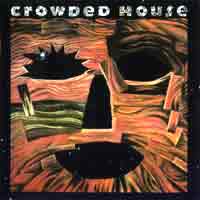 Auf diesem Album ist fast jeder Song ein Hit: Natürlich "
Weather With
You", aber z.B. auch "Fall At Your Feet" (mein persönlicher
Favourit) und "Four Seasons In One Day". Zum Kerntrio um Sänger/Gitarrist
Neil Finn, Trommler Paul Hester und Bassist Nick Seymour
war Tim Finn gestoßen, der eigentlich nur zeitgleich mit seinem
Bruder in L.A. ein Soloalbum bzw. eine Duoplatte aufnehmen wollte. Dokumentiert
ist das Ganze übrigens in einer der ersten (und besten) MTV-Unplugged
Sendungen vom Frühjahr 1991. Die Zusammenarbeit der Brüder klappte
so gut, dass Tim zumindest für eine Saison ganz in der Band seines
Bruders anheuerte.
Auf diesem Album ist fast jeder Song ein Hit: Natürlich "
Weather With
You", aber z.B. auch "Fall At Your Feet" (mein persönlicher
Favourit) und "Four Seasons In One Day". Zum Kerntrio um Sänger/Gitarrist
Neil Finn, Trommler Paul Hester und Bassist Nick Seymour
war Tim Finn gestoßen, der eigentlich nur zeitgleich mit seinem
Bruder in L.A. ein Soloalbum bzw. eine Duoplatte aufnehmen wollte. Dokumentiert
ist das Ganze übrigens in einer der ersten (und besten) MTV-Unplugged
Sendungen vom Frühjahr 1991. Die Zusammenarbeit der Brüder klappte
so gut, dass Tim zumindest für eine Saison ganz in der Band seines
Bruders anheuerte. |
 weitere Highlights ...
weitere Highlights ...
| Dinosaur Jr: "Green Mind" (Blanco Y Negro, Feb. 1991) |
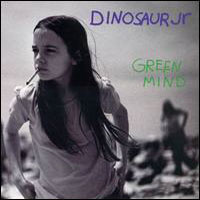 In der Grabbelkiste gefunden!
In der Grabbelkiste gefunden!(19.07.2009)  Mehr ...
Mehr ...
|
| Eleventh Dream Day: "Lived To Tell" (Atlantic, Feb.1991) |
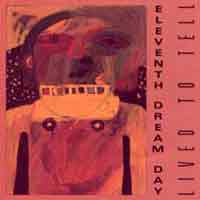
 Mehr ...
Mehr ...
|
| Roger McGuinn: "Back From Rio" (Arista, Feb. 1991) |
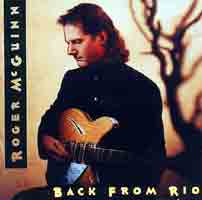 Hier
zuerst eine kleine Anekdote: Ich kam im Frühjahr 1991 in Lothars
Plattenladen in Wesel, als da ein mir unbekanntes Lied mit typischer
Byrds-Gitarre (12string-Ricky) lief. Ich
stutzte und dachte noch: das klingt aber auch verdammt nach Elvis
Costello! Es stellte sich dann natürlich als "You Bowed
Down" von der brandneuen McGuinn-Platte heraus, komponiert von
(ihr werdet es erraten) Elvis Costello. Da war
ich natürlich schon ein bisschen stolz auf meine Ohren. Hier
zuerst eine kleine Anekdote: Ich kam im Frühjahr 1991 in Lothars
Plattenladen in Wesel, als da ein mir unbekanntes Lied mit typischer
Byrds-Gitarre (12string-Ricky) lief. Ich
stutzte und dachte noch: das klingt aber auch verdammt nach Elvis
Costello! Es stellte sich dann natürlich als "You Bowed
Down" von der brandneuen McGuinn-Platte heraus, komponiert von
(ihr werdet es erraten) Elvis Costello. Da war
ich natürlich schon ein bisschen stolz auf meine Ohren. Auch der Rest der Scheibe ist nicht schlecht, als Begleiter und/oder Songschreiber tun sich zum Beispiel Tom Petty, sein Gitarrist Mike Campbell und sein Drummer Stan Lynch hervor. Man kann auch unschwer erkennen, dass sich Tom Petty und seine Herzensbrecher viel Inspiration von den Byrds geholt haben. Leider hat McGuinn danach nichts erwähnenswertes mehr zustande gebracht. |
| Julian Cope: "Peggy Suicide" (Island, März 1991) |
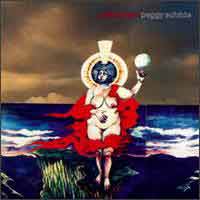 Der Mann war früher mal der Kopf von Teardrop Explodes, die ich
als Teil der New-Wave-Szene Ende der 70er kaum wahrgenommen habe (jetzt
im Nachhinein gehört klingen T.E.-Alben ganz OK). Aber erst seine
Soloalben haben mich auf ihn aufmerksam gemacht. Das fing an mit einer
merkwürdigen Platte, auf der er sich mit einem Schildkrötenpanzer
ablichten ließ ("Fried" von 1984), dann kam ein (natürlich
erfolgloser) Versuch, die Charts zustürmen ("Saint Julian"
von 1987). Bei "Peggy Suicide" schlägt der Kommerzpendel
wieder zurück, aber auf einem derart hohen künstlerischen
Niveau, dass man ohne rot zu werden von einem Meisterwerk sprechen kann!
Der Mann war früher mal der Kopf von Teardrop Explodes, die ich
als Teil der New-Wave-Szene Ende der 70er kaum wahrgenommen habe (jetzt
im Nachhinein gehört klingen T.E.-Alben ganz OK). Aber erst seine
Soloalben haben mich auf ihn aufmerksam gemacht. Das fing an mit einer
merkwürdigen Platte, auf der er sich mit einem Schildkrötenpanzer
ablichten ließ ("Fried" von 1984), dann kam ein (natürlich
erfolgloser) Versuch, die Charts zustürmen ("Saint Julian"
von 1987). Bei "Peggy Suicide" schlägt der Kommerzpendel
wieder zurück, aber auf einem derart hohen künstlerischen
Niveau, dass man ohne rot zu werden von einem Meisterwerk sprechen kann!
 Mehr ...
Mehr ...
|
| "Jerry Garcia/David Grisman" (Acoustic Discs, März 1991) |
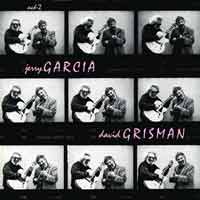 Dies
ist die erste CD einer ganzen Reihe von Duoplatte, die Jerry Garcia
und sein alter Bluegrasskumpel "Dawg" Grisman aufgenommen
haben - und wohl auch die Beste (nach Jerry's Tod hat Grisman weitere
Bänder aufbereitet, die alle irgendwie nicht schlecht sind, aber
eben nicht so gut wie dieses Album). Live eingespielt und von Jim
Kerwin (Bass) und Joe Craven (Perkussion & Geige) unterstützt
gibt's den Dead-Klassiker "Friend Of The Devil" in einer tollen
Version (Grisman war 1970 auf der Originalversion auf "American
Beauty" schon mit seiner Mandoline dabei!), Hoagy Carmichaels
"Rockin' Chair", Irving Berlin's "Russian Lullaby",
den Bluesklassiker "The Thrill Is Gone" und als Höhepunkt
ein furioses Gitarren-Mandolinen-Duell ("Arabia"). Dies
ist die erste CD einer ganzen Reihe von Duoplatte, die Jerry Garcia
und sein alter Bluegrasskumpel "Dawg" Grisman aufgenommen
haben - und wohl auch die Beste (nach Jerry's Tod hat Grisman weitere
Bänder aufbereitet, die alle irgendwie nicht schlecht sind, aber
eben nicht so gut wie dieses Album). Live eingespielt und von Jim
Kerwin (Bass) und Joe Craven (Perkussion & Geige) unterstützt
gibt's den Dead-Klassiker "Friend Of The Devil" in einer tollen
Version (Grisman war 1970 auf der Originalversion auf "American
Beauty" schon mit seiner Mandoline dabei!), Hoagy Carmichaels
"Rockin' Chair", Irving Berlin's "Russian Lullaby",
den Bluesklassiker "The Thrill Is Gone" und als Höhepunkt
ein furioses Gitarren-Mandolinen-Duell ("Arabia"). |
| Elliott Murphy: "12" (New Rose, März 1991) |
 Das französische New Rose-Label war damals für einige
schöne Musik verantwortlich. Oft waren das amerikanische Sänger
oder Bands, die in ihrer Heimat nicht (mehr) die richtige Anerkennung
bekamen. Elliott Murphy ist so einer.
Das französische New Rose-Label war damals für einige
schöne Musik verantwortlich. Oft waren das amerikanische Sänger
oder Bands, die in ihrer Heimat nicht (mehr) die richtige Anerkennung
bekamen. Elliott Murphy ist so einer.
 Mehr ...
Mehr ...
|
| Massive Attack: "Blue Lines" (Virgin, April 1991) |
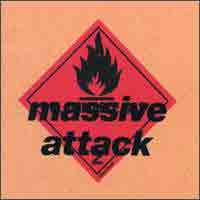 Ist
das jetzt Hip-Hop? Oder Trip-Hop? Keine Ahnung, eben nicht mein Fachgebiet.
Aber auch mir als "Außenstehendem" ist das Album aufgefallen.
Mit dem berühmen Billy Cobham-Sample
im Single-Hit "Safe From Harm" ("I was looking back at
her, if she was looking back at me ..."). Ist
das jetzt Hip-Hop? Oder Trip-Hop? Keine Ahnung, eben nicht mein Fachgebiet.
Aber auch mir als "Außenstehendem" ist das Album aufgefallen.
Mit dem berühmen Billy Cobham-Sample
im Single-Hit "Safe From Harm" ("I was looking back at
her, if she was looking back at me ..."). |
| Mekons: "The Curse Of The Mekons" (Sin, April 1991) |
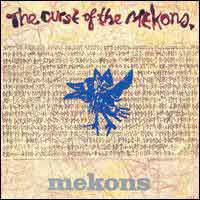 1990
gab's einen kurzen Flirt mit dem Majorlabel A&M. Dabei entstand
die abgedrehte Maxi "F.U.N. 90", die die Plattenbosse wohl
ziemlich verschreckt haben muss. Beim alten Heimatlabel Sin ging's dann
aber in aller Frische weiter. "Curse" steigert noch mal das,
was "Rock N' Roll"
schon andeutete! 1990
gab's einen kurzen Flirt mit dem Majorlabel A&M. Dabei entstand
die abgedrehte Maxi "F.U.N. 90", die die Plattenbosse wohl
ziemlich verschreckt haben muss. Beim alten Heimatlabel Sin ging's dann
aber in aller Frische weiter. "Curse" steigert noch mal das,
was "Rock N' Roll"
schon andeutete! |
| This Mortal Coil: "Blood" (4AD, April 1991) |
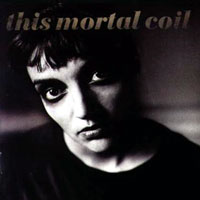 Der
dritte Streich von Ivo Watts-Russell, hauptberuflich Labelboss
von 4AD, und dem Produzenten John Fryer erschien völlig
überraschend mit 5jährigem Abstand zum genialen Vorgänger
"Filigree & Shadow".
Aufbauend auf dem allgegenwärtigen Streicherensemble um Martin
McCarrick, Sally Herbert und Jocelyn Pook wurden wieder
viele Gäste eingeladen (u. a. Tanya Donnelly und Kim
Deal von den Breeders, Heidi Berry, Caroline Crawley
von Shelleyan Orphan), um sphärische Eigenkompositionen
von Fryer, McCarrick und Watts-Russell und ungewöhnliche Coverversionen
aufzunehmen, z.B.: "With Tomorrow" (Gene
Clark/Byrds), "You And Your Sister" und "I Am The
Cosmos" (Chris Bell/Big
Star), "Nature's Way" (Randy California/Spirit), "Late
Night" (Syd Barrett/Pink Floyd) und "Help Me Lift You Up"
(Mary-Margret O'Hara). Der
dritte Streich von Ivo Watts-Russell, hauptberuflich Labelboss
von 4AD, und dem Produzenten John Fryer erschien völlig
überraschend mit 5jährigem Abstand zum genialen Vorgänger
"Filigree & Shadow".
Aufbauend auf dem allgegenwärtigen Streicherensemble um Martin
McCarrick, Sally Herbert und Jocelyn Pook wurden wieder
viele Gäste eingeladen (u. a. Tanya Donnelly und Kim
Deal von den Breeders, Heidi Berry, Caroline Crawley
von Shelleyan Orphan), um sphärische Eigenkompositionen
von Fryer, McCarrick und Watts-Russell und ungewöhnliche Coverversionen
aufzunehmen, z.B.: "With Tomorrow" (Gene
Clark/Byrds), "You And Your Sister" und "I Am The
Cosmos" (Chris Bell/Big
Star), "Nature's Way" (Randy California/Spirit), "Late
Night" (Syd Barrett/Pink Floyd) und "Help Me Lift You Up"
(Mary-Margret O'Hara). |
| Elvis Costello: "Mighty Like A Rose" (Warner, Mai 1991) |
|
Elvis hat hier eine Band von Spitzenkönnern um sich versammelt, die sich aber alle den Songs unterordnen: Larry Knechtel (p), Marc Ribot (g), Mitchell Froom, Nick Lowe (bg), Jerry Scheff (bg), Jim Keltner (dr), aus New Orleans die Dirty Dozen Brass Band u.v.a. |
| Richard Thompson: "Rumour & Sigh" (Capitol, Mai 1991) |
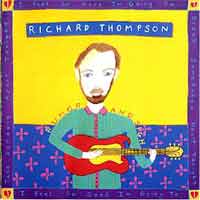 Wie
immer in den 90ern: ein gutes Album mit scheußlichem Cover von
einem der besten britischen Songschreiber und Gitarristen, der seit
einiger Zeit in den USA beheimatet ist. Vom Keyboarder Mitchell Froom
in L.A. betreut und mit dessen "üblichen Verdächtigen"
eingespielt: Jim Keltner (dr) und Jerry Scheff (bg). Folkloristische
Akzente setzen alte Kollegen aus britischen Folkrocktagen: Simon
Nicol (g), Clive Gregson+Christine Collister (v),
John Kirkpatrick (acc), Aly Bain (vio) und Phil Pickett
(Blasinstrumente). Für mich wird dieser Mann komplett unterschätzt,
denn wo gibt es schon mal jemanden mit zwei solchen Ausnahmetalenten?
Da fällt mir höchsten noch Bruce Cockburn ein. Wie
immer in den 90ern: ein gutes Album mit scheußlichem Cover von
einem der besten britischen Songschreiber und Gitarristen, der seit
einiger Zeit in den USA beheimatet ist. Vom Keyboarder Mitchell Froom
in L.A. betreut und mit dessen "üblichen Verdächtigen"
eingespielt: Jim Keltner (dr) und Jerry Scheff (bg). Folkloristische
Akzente setzen alte Kollegen aus britischen Folkrocktagen: Simon
Nicol (g), Clive Gregson+Christine Collister (v),
John Kirkpatrick (acc), Aly Bain (vio) und Phil Pickett
(Blasinstrumente). Für mich wird dieser Mann komplett unterschätzt,
denn wo gibt es schon mal jemanden mit zwei solchen Ausnahmetalenten?
Da fällt mir höchsten noch Bruce Cockburn ein. |
| Yo La Tengo: "That Is Yo La Tengo" (City Slang, Mai 1991) |
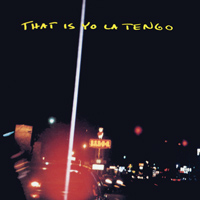 Wiedergefunden in der Grabbelkiste!
Wiedergefunden in der Grabbelkiste!(24.01.2014) |
| FSK: "Son Of Kraut" (Sub Up, Juni 1991) |
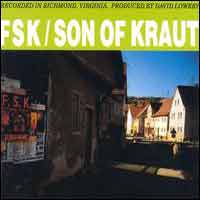 Diese
Band aus München um den Sänger, Gitarristen, Kornettspieler,
Lapsteeler, Buchautor und Radio-DJ Thomas Meinecke hat einen
interessanten Wandel durchgemacht: gegründet in der Zeit der "Neuen
Deutschen Welle" hat man sich aber zunehmend mehr für amerikanische
Musik interessiert und diese Album sogar in Virginia unter der Mithilfe
von David Lowery (Camper Van Beethoven, Cracker) aufgenommen. Diese
Band aus München um den Sänger, Gitarristen, Kornettspieler,
Lapsteeler, Buchautor und Radio-DJ Thomas Meinecke hat einen
interessanten Wandel durchgemacht: gegründet in der Zeit der "Neuen
Deutschen Welle" hat man sich aber zunehmend mehr für amerikanische
Musik interessiert und diese Album sogar in Virginia unter der Mithilfe
von David Lowery (Camper Van Beethoven, Cracker) aufgenommen.
|
| Graham Parker: "Struck By Lightning" (Demon/RCA, Juni 1991) |
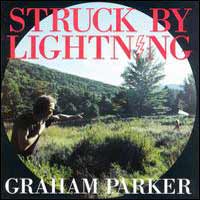
 Mehr ...
Mehr ...
|
| Blue Aeroplanes: "Beatsongs" (Chryalis/Ensign, Aug. 1991) |
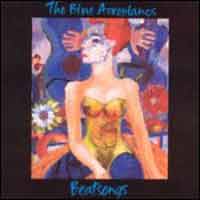 Obwohl die Band aus Bristol schon mehrere Alben veröffentlicht hatte,
erreichten sie erst mit diesem zweiten Major-Release auch außerhalb
Englands etwas größere Aufmerksamkeit. Dabei wird hier "eigentlich"
nur ganz normale gitarrenorientierte Rockmusik geboten, allerdings gleich
mit drei (!) Gitarristen, wie damals bei Lynyrd Skynyrd (das ist aber
Gott sei Dank die einzige Gemeinsamkeit!). Im Mittelpunkt stehen die
Texte von "Sänger" Gerald Langley, den man eigentlich
eher "Sprecher" nennen müsste, da er definitiv ohne Melodien
auskommt und die einzige Konstante in den wechselnder Bandbesetzungen
ist. Sollte ein Lied dann doch mal eine richtige Melodie brauchen, so
übernimmt das Singen dann einer der drei Gitarristen. Zum festen
Lineup gehört auch ein polnischer Tänzer (!). Davon, dass
das Ganze keine Spinnerei von Engländern ist, konnte ich mich mal
bei einem Liveauftritt in einer Halderner Dorfdisco überzeugen.
"Beatsongs" enthält klasse Songs, z.B. die Single "Yr
Own World" und meiner Lieblingsnummer "Cardboard Box"
und die Coverversion von Paul Simon: "Boy In The Bubble".
Obwohl die Band aus Bristol schon mehrere Alben veröffentlicht hatte,
erreichten sie erst mit diesem zweiten Major-Release auch außerhalb
Englands etwas größere Aufmerksamkeit. Dabei wird hier "eigentlich"
nur ganz normale gitarrenorientierte Rockmusik geboten, allerdings gleich
mit drei (!) Gitarristen, wie damals bei Lynyrd Skynyrd (das ist aber
Gott sei Dank die einzige Gemeinsamkeit!). Im Mittelpunkt stehen die
Texte von "Sänger" Gerald Langley, den man eigentlich
eher "Sprecher" nennen müsste, da er definitiv ohne Melodien
auskommt und die einzige Konstante in den wechselnder Bandbesetzungen
ist. Sollte ein Lied dann doch mal eine richtige Melodie brauchen, so
übernimmt das Singen dann einer der drei Gitarristen. Zum festen
Lineup gehört auch ein polnischer Tänzer (!). Davon, dass
das Ganze keine Spinnerei von Engländern ist, konnte ich mich mal
bei einem Liveauftritt in einer Halderner Dorfdisco überzeugen.
"Beatsongs" enthält klasse Songs, z.B. die Single "Yr
Own World" und meiner Lieblingsnummer "Cardboard Box"
und die Coverversion von Paul Simon: "Boy In The Bubble".
 Mehr ...
Mehr ...
|
| Van Morrison: "Hymns To The Silence" (Polydor/Exile, Sept. 1991) |
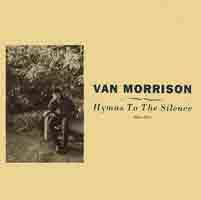 Mal
wieder ein grandioses Album des Meisters der tiefen Gefühle. Das
Ganze ist dann auch noch eine Doppel-CD und trotzdem völlig ohne
überflüssiges. Neben Vans Songs (herausragend: "Take me
Back", das den Geist von meisterlichen Liedern wie "Common One"
und "Listen To The Lion" wieder
aufleben lässt) und Gesang steht die Orgel von Georgie Fame im Mittelpunkt. Mal
wieder ein grandioses Album des Meisters der tiefen Gefühle. Das
Ganze ist dann auch noch eine Doppel-CD und trotzdem völlig ohne
überflüssiges. Neben Vans Songs (herausragend: "Take me
Back", das den Geist von meisterlichen Liedern wie "Common One"
und "Listen To The Lion" wieder
aufleben lässt) und Gesang steht die Orgel von Georgie Fame im Mittelpunkt.
 Mehr ...
Mehr ...
|
| Nirvana: "Nevermind" (Geffen/Sub Pop, Sept. 1991) |
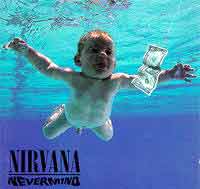 Im Sommer '91 war ich mit ein paar Kumpels auf dem Spex-Festival im
Kölner Tanzbrunnen. Da ich mich damals nach einem Unfall beim Tanzen
(wirklich!) nur mit Krücken bewegen konnte, kann ich mich noch
gut daran erinnern, wie ich die ganze Zeit dort nur herumsaß und der
Musik lauschte. Eigentlich war ich ja nur wegen Sonic Youth da.
Es spielten aber auch Nirvana, die ich nur dem Namen nach von einem
SPEX-Artikel zu ihrem ersten (und nach meinem Geschmack nicht so dollen)
Album "Bleach" her kannte: und sie waren total beeindruckend,
stachen aus dem Lineup des Festivals deutlich heraus. Im Herbst stand
dann "Nevermind" im Plattenregal von Lothars "Popshop"
in Wesel und ich habe mir das Album dann aufgrund des guten Eindrucks
von dem Auftritt zugelegt. Allerdings ging ich immer noch davon aus,
dass es sich dabei um das übliche Insiderding handelt, bis mich
Lothar darauf aufmerksam machte, dass die Platte sich "ziemlich
gut" verkaufen würde, was ich damals kaum glauben konnte.
Trotzdem hat dann keiner von uns damit gerechnet, dass im Frühjahr
1992 mit der Single "Smells Like Teen Spirit" DERMASSEN die
Post abgehen würde!
Im Sommer '91 war ich mit ein paar Kumpels auf dem Spex-Festival im
Kölner Tanzbrunnen. Da ich mich damals nach einem Unfall beim Tanzen
(wirklich!) nur mit Krücken bewegen konnte, kann ich mich noch
gut daran erinnern, wie ich die ganze Zeit dort nur herumsaß und der
Musik lauschte. Eigentlich war ich ja nur wegen Sonic Youth da.
Es spielten aber auch Nirvana, die ich nur dem Namen nach von einem
SPEX-Artikel zu ihrem ersten (und nach meinem Geschmack nicht so dollen)
Album "Bleach" her kannte: und sie waren total beeindruckend,
stachen aus dem Lineup des Festivals deutlich heraus. Im Herbst stand
dann "Nevermind" im Plattenregal von Lothars "Popshop"
in Wesel und ich habe mir das Album dann aufgrund des guten Eindrucks
von dem Auftritt zugelegt. Allerdings ging ich immer noch davon aus,
dass es sich dabei um das übliche Insiderding handelt, bis mich
Lothar darauf aufmerksam machte, dass die Platte sich "ziemlich
gut" verkaufen würde, was ich damals kaum glauben konnte.
Trotzdem hat dann keiner von uns damit gerechnet, dass im Frühjahr
1992 mit der Single "Smells Like Teen Spirit" DERMASSEN die
Post abgehen würde!
 Mehr ...
Mehr ...
|
| The Perc Meets The Hidden Gentleman: "Lavender" (Strange Ways, Sept. 1991) |
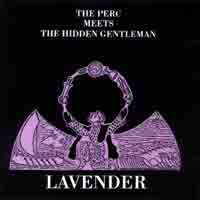 Das Meisterwerk des inzwischen zu einer kompletten Band angewachsenen Duos
Tom Redecker und Emilio Winschetti - und außerdem ein
(ACHTUNG UNCOOL!) KONZEPTALBUM über die uralte Kulturpflanze
Lavendel. Für den Song "The Moon On Both Sides" würden
Pink Floyd wahrscheinlich über Leichen gehen.
Das Meisterwerk des inzwischen zu einer kompletten Band angewachsenen Duos
Tom Redecker und Emilio Winschetti - und außerdem ein
(ACHTUNG UNCOOL!) KONZEPTALBUM über die uralte Kulturpflanze
Lavendel. Für den Song "The Moon On Both Sides" würden
Pink Floyd wahrscheinlich über Leichen gehen.
|
| Red Hot Chili Peppers: "Blood Sugar Sex Magik" (Warner, Sept. 1991) |

 Mehr ...
Mehr ...
|
| American Music Club: "Everclear" (Alias, Okt. 1991) |
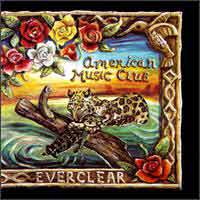 Der
American Music Club war das Vehikel des Sängers und Songschreibers
Mark Eitzel. "Everclear" war das letzte Album bei einem
Independentlabel, bevor irgend jemand bei Virgin auf die Idee kam, den
AMC groß herausbringen zu wollen. Nach zwei künstlerisch ebenso
gelungenen Major-Veröffentlichungen war dann Schluss, der Club
schloss seine Pforten. Wir hören auf allen Alben der Band wunderschöne,
aber doch tieftraurige Musik. Nichts für Selbstmordgefährdete. Der
American Music Club war das Vehikel des Sängers und Songschreibers
Mark Eitzel. "Everclear" war das letzte Album bei einem
Independentlabel, bevor irgend jemand bei Virgin auf die Idee kam, den
AMC groß herausbringen zu wollen. Nach zwei künstlerisch ebenso
gelungenen Major-Veröffentlichungen war dann Schluss, der Club
schloss seine Pforten. Wir hören auf allen Alben der Band wunderschöne,
aber doch tieftraurige Musik. Nichts für Selbstmordgefährdete. |
| Bruce Cockburn: "Nothing But A Burning Light" (Columbia, Okt. 1991) |
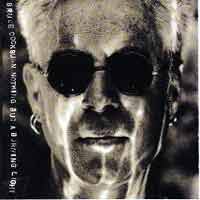 Den
kanadischen "Politrocker" hatte ich eigentlich gar nicht auf
meiner Rechnung - und dann ausgerechnet bei einem großen Laden eine
dermaßen gute Produktion (dank T-Bone Burnett!), klasse Songs,
Gesang und Gitarre von Cockburn und eine ganz feine Begleitband:
Booker T. Jones (Orgel), Jim Keltner (Schlagzeug) und Edgar
Meyer (Kontrabass), ergänzt durch interessante Gastmusiker:
u.a. Mark O'Connor an Geige und diversen Saiteninstrumenten,
sowie Jackson Browne und Burnett's Gattin Sam Phillips
im Backgroundchor. Den
kanadischen "Politrocker" hatte ich eigentlich gar nicht auf
meiner Rechnung - und dann ausgerechnet bei einem großen Laden eine
dermaßen gute Produktion (dank T-Bone Burnett!), klasse Songs,
Gesang und Gitarre von Cockburn und eine ganz feine Begleitband:
Booker T. Jones (Orgel), Jim Keltner (Schlagzeug) und Edgar
Meyer (Kontrabass), ergänzt durch interessante Gastmusiker:
u.a. Mark O'Connor an Geige und diversen Saiteninstrumenten,
sowie Jackson Browne und Burnett's Gattin Sam Phillips
im Backgroundchor. |
| The Cocoon: "Stretching Things" (What's So Funny About, Okt. 1991) |
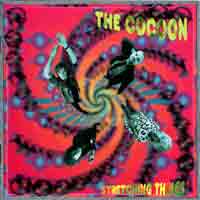 "Psychedelik-Rock
& Fusion-Jazz" - ein blödes Etikett, aber es ist schwer
den Stil dieser Platte zu beschreiben. Vielleicht einfach die beteiligten
Musiker erwähnen? Jazzlegende Gunther Hampel an Vibraphon,
Keyboards und Blasinstrumenten, Gitarrist und Toningenieur Matthias
Arfmann (Kastrierte Philosophen),
Sänger/Gitarrist Jürgen Gleue von den legendären 39 Clocks
und Schlagzeuger Rüdiger Klose (Kastrierte
Philosophen und auch Mitwirkender bei den 39 Clocks). Eine
starke und unvergleichliche Platte! "Psychedelik-Rock
& Fusion-Jazz" - ein blödes Etikett, aber es ist schwer
den Stil dieser Platte zu beschreiben. Vielleicht einfach die beteiligten
Musiker erwähnen? Jazzlegende Gunther Hampel an Vibraphon,
Keyboards und Blasinstrumenten, Gitarrist und Toningenieur Matthias
Arfmann (Kastrierte Philosophen),
Sänger/Gitarrist Jürgen Gleue von den legendären 39 Clocks
und Schlagzeuger Rüdiger Klose (Kastrierte
Philosophen und auch Mitwirkender bei den 39 Clocks). Eine
starke und unvergleichliche Platte! |
| Garland Jeffreys: "Don't Call Me Buckwheat" (RCA, Okt. 1991) |
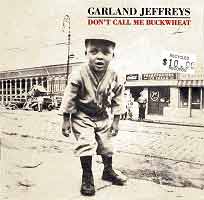 Nach
fast 10jähriger Pause mal wieder ein Album des New-Yorker Querdenkers,
der hier seine Lebensgeschichte als Mischlingskind zwischen Schwarzen
und Weißen thematisiert. Es gibt mit "Hail, Hail, Rock'n'Roll"
sogar eine Single, die zwar nicht die Charts stürmte, aber viel
Radio-Airplay bekam. Wie immer bei Jeffreys war das eigene Material
überzeugend (auch mit modernen Hiphop-Elementen) und die musikalische
Umsetzung perfekt. Dafür sorgten u. a.: Steve Jordan (dr),
Sly & Robbie (Jamaikas beste Rhythmusgruppe), Hugh McCracken
(g), Paul Griffin (p), Mike Brecker (sax), Bernard
Purdie (dr), G. E. Smith (g), Vernon Reed (g) und
auch sein alter Weggenosse Alan Freedman (g). Nach
fast 10jähriger Pause mal wieder ein Album des New-Yorker Querdenkers,
der hier seine Lebensgeschichte als Mischlingskind zwischen Schwarzen
und Weißen thematisiert. Es gibt mit "Hail, Hail, Rock'n'Roll"
sogar eine Single, die zwar nicht die Charts stürmte, aber viel
Radio-Airplay bekam. Wie immer bei Jeffreys war das eigene Material
überzeugend (auch mit modernen Hiphop-Elementen) und die musikalische
Umsetzung perfekt. Dafür sorgten u. a.: Steve Jordan (dr),
Sly & Robbie (Jamaikas beste Rhythmusgruppe), Hugh McCracken
(g), Paul Griffin (p), Mike Brecker (sax), Bernard
Purdie (dr), G. E. Smith (g), Vernon Reed (g) und
auch sein alter Weggenosse Alan Freedman (g). |
| Talk Talk: "Laughing Stock" (Verve, Okt. 1991) |
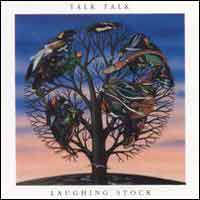 Wenn
das keine Veradelung ist! Auf dem amerikanischen Jazzlabel Verve erscheint
der Schwanengesang von Mark Hollis (die anderen Bandmitglieder,
Bassist Paul Webb und Drummer Lee Harris, spielen eine
eher untergeordnete Rolle). Wenn
das keine Veradelung ist! Auf dem amerikanischen Jazzlabel Verve erscheint
der Schwanengesang von Mark Hollis (die anderen Bandmitglieder,
Bassist Paul Webb und Drummer Lee Harris, spielen eine
eher untergeordnete Rolle). |
| Teenage Fanclub: "Bandwagonesque" (Creation, Nov. 1991) |
 Ein kleine aber feine Gitarrenband aus Schottland, die nie an der Spitze,
aber immer spitzenklasse war und alle Strömungen - auch den Britpop
- überlebt hat.
Ein kleine aber feine Gitarrenband aus Schottland, die nie an der Spitze,
aber immer spitzenklasse war und alle Strömungen - auch den Britpop
- überlebt hat.
 Mehr ...
Mehr ...
|
| Sister Double Happiness: "Heart And Mind" (Reprise, Dez. 1991) |
 "Blueshardrock" (i.w.S.) vom Feinsten. Das zweite Album der
Band um den schwergewichtigen Sänger Gary Floyd, Ex-Punkrocker
und bekennender Schwuler, der sich auch in seinen wunderschönen
Liebestexten nicht versteckt, sondern ganz offen von "him"
singt. Da das Album nach dem SST-Debüt von 1988 bei einem
Majorlabel erschien, wird es von vielen als das schwächere Album
eingeschätzt, aber ich kann diese Einschätzung nicht teilen
(SST=Independent=Kult, Reprise=Major=Pfui). Zwar werden zwei Songs vom
Debüt in neuen Versionen unter die Leute gebracht ("Sweet
Talker" und der Ohrwurm "You Don't Know Me"), dazu kommt
aber mit "Exposed To You" ein Konzert-Highlight und mein absolutes
Lieblingsstück von der Band. Zudem gibt es neben dem härteren
Bluesrock der Band, nicht unähnlich dem mancher großen Bluesrocker
aus den 70ern (z.B. Free oder ZZ Top), sogar mit "The
Sailor Song" einen wunderschönen Countrysong und in der abschließenden
Ballade "You For You" zeigt die Trommlerin Lynn Perko
(live sehr beeindruckend!) auch am Klavier ihr Können. Natürlich
(?) war die Platte bei allen Anstrengungen auf dem Mainstreammarkt ein
totaler Flopp. Ach ja - und irgendwo auf der Platte macht unser guter
alter John Cale "Radar Blips".
"Blueshardrock" (i.w.S.) vom Feinsten. Das zweite Album der
Band um den schwergewichtigen Sänger Gary Floyd, Ex-Punkrocker
und bekennender Schwuler, der sich auch in seinen wunderschönen
Liebestexten nicht versteckt, sondern ganz offen von "him"
singt. Da das Album nach dem SST-Debüt von 1988 bei einem
Majorlabel erschien, wird es von vielen als das schwächere Album
eingeschätzt, aber ich kann diese Einschätzung nicht teilen
(SST=Independent=Kult, Reprise=Major=Pfui). Zwar werden zwei Songs vom
Debüt in neuen Versionen unter die Leute gebracht ("Sweet
Talker" und der Ohrwurm "You Don't Know Me"), dazu kommt
aber mit "Exposed To You" ein Konzert-Highlight und mein absolutes
Lieblingsstück von der Band. Zudem gibt es neben dem härteren
Bluesrock der Band, nicht unähnlich dem mancher großen Bluesrocker
aus den 70ern (z.B. Free oder ZZ Top), sogar mit "The
Sailor Song" einen wunderschönen Countrysong und in der abschließenden
Ballade "You For You" zeigt die Trommlerin Lynn Perko
(live sehr beeindruckend!) auch am Klavier ihr Können. Natürlich
(?) war die Platte bei allen Anstrengungen auf dem Mainstreammarkt ein
totaler Flopp. Ach ja - und irgendwo auf der Platte macht unser guter
alter John Cale "Radar Blips".
 Mehr ...
Mehr ...
|
| Biff Bang Pow! "L'amour, Demure, Stenhousemuir" (Creation, 1991) |
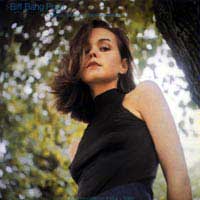 Alan
McGee ist eigentlich Labelboss bei Creation (und somit mit Oasis
zu Geld gekommen) und betrieb zusammen mit dem Gitarristen Richard
Green diese "Hobbyband". Das vorliegende Album fiel mir,
muss ich gestehen, zuerst wegen des Coverfotos auf (Hach ja!), blieb
aber dann wegen der wunderbaren und zerbrechlichen, an den späten
60ern orientierten und trotzdem nicht altmodischen Gitarrenmusik lange
auf meinem Plattenteller. Der Covertext macht es zwar nicht deutlich,
aber es handelt sich um eine Single/Maxi-Compilation der Jahre 1984-91. Alan
McGee ist eigentlich Labelboss bei Creation (und somit mit Oasis
zu Geld gekommen) und betrieb zusammen mit dem Gitarristen Richard
Green diese "Hobbyband". Das vorliegende Album fiel mir,
muss ich gestehen, zuerst wegen des Coverfotos auf (Hach ja!), blieb
aber dann wegen der wunderbaren und zerbrechlichen, an den späten
60ern orientierten und trotzdem nicht altmodischen Gitarrenmusik lange
auf meinem Plattenteller. Der Covertext macht es zwar nicht deutlich,
aber es handelt sich um eine Single/Maxi-Compilation der Jahre 1984-91. |
| Fatima Mansions: "Viva Dead Ponies" (Radioactive/Kitchenware, 1990/1991) |
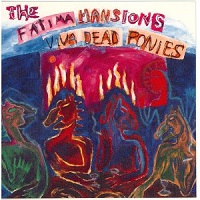 Microdisney]
Microdisney]
 Mehr ...
Mehr ...
|
| Monks Of Doom: "Meridian" (Baited Breath, 1991) |
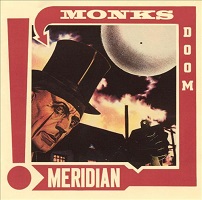 Im Prinzip sind das hier Camper Van Beethoven
ohne deren Sänger David Lowery, also Bassist Victor Krumenacker,
Gitarrist Greg Lisher und Drummer Chris Pedersen, zusammen
mit Gitarrist David Immerglück.
Im Prinzip sind das hier Camper Van Beethoven
ohne deren Sänger David Lowery, also Bassist Victor Krumenacker,
Gitarrist Greg Lisher und Drummer Chris Pedersen, zusammen
mit Gitarrist David Immerglück. |
| Matthew Sweet: "Girlfriend" (ZOO, 1991) |
 Kaum
von der öffentlichkeit beachtet bringt der Gitarrist, Bassist,
Sänger & Songschreiber wunderbare Alben heraus. Daneben war
er mir nur am Rande als Mitspieler bei Lloyd Cole und Anton Fiers
Golden Palominos aufgefallen. Tolles Cover, nicht wahr? Kaum
von der öffentlichkeit beachtet bringt der Gitarrist, Bassist,
Sänger & Songschreiber wunderbare Alben heraus. Daneben war
er mir nur am Rande als Mitspieler bei Lloyd Cole und Anton Fiers
Golden Palominos aufgefallen. Tolles Cover, nicht wahr? |
| Union Carbide Productions: "From Influence To Ignorance" (Radium/MNW, 1991) |
 Tolle Platte! Hatte ich völlig vergessen und erst jetzt, wo Ebbot
Lundbergs neue Band "The Soundtrack
Of Our Lives" auch bei uns bekannter wird (u. a. durch den
tollen Auftritt beim Haldern Openair!) und ich die alte CD rausgekramt
habe, fällt mir das wieder auf. Allerbester SCHWEINEROCK aus Schweden!!!
Iggy, eat our heart out!
Tolle Platte! Hatte ich völlig vergessen und erst jetzt, wo Ebbot
Lundbergs neue Band "The Soundtrack
Of Our Lives" auch bei uns bekannter wird (u. a. durch den
tollen Auftritt beim Haldern Openair!) und ich die alte CD rausgekramt
habe, fällt mir das wieder auf. Allerbester SCHWEINEROCK aus Schweden!!!
Iggy, eat our heart out!(10.11.2004)  Mehr ...
Mehr ...
|
| The Wellsprings Of Hope: "Phonograph" (Safety Net, 1991) |
 "Garagesoul"
von Pat Johnson aus San Francisco, den der eine oder andere von
Euch vielleicht als Gitarrist und Songschreiber von/für Penelope
Houston kennt, zusammen mit zahlreichen Mitstreitern aus der Bay-Area-Szene.
Singer/Songwriter- Musik mit Wurzeln im Garagenrock (=Gitarre) und Soul
(=Bläser). "Garagesoul"
von Pat Johnson aus San Francisco, den der eine oder andere von
Euch vielleicht als Gitarrist und Songschreiber von/für Penelope
Houston kennt, zusammen mit zahlreichen Mitstreitern aus der Bay-Area-Szene.
Singer/Songwriter- Musik mit Wurzeln im Garagenrock (=Gitarre) und Soul
(=Bläser). |

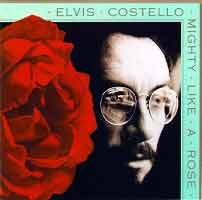 It's
like the anger thing. It's only as useful to you as you can employ
it. You can't always be in a rage about everything, a curmudgeon.
I mean, why would anyone be like that? You'd just make yourself miserable.
I guess there are people like that but I'm not one of them. Maybe
what you learn over a period of time is how to use it, like a beam
on a particular thing you're moved to write about...As for hate, on
the evidence of Mighty Like A Rose, I'd have to say yes, I don't consciously
invite it, it's just the way it is". (EC)
It's
like the anger thing. It's only as useful to you as you can employ
it. You can't always be in a rage about everything, a curmudgeon.
I mean, why would anyone be like that? You'd just make yourself miserable.
I guess there are people like that but I'm not one of them. Maybe
what you learn over a period of time is how to use it, like a beam
on a particular thing you're moved to write about...As for hate, on
the evidence of Mighty Like A Rose, I'd have to say yes, I don't consciously
invite it, it's just the way it is". (EC)
(2019-12-08)